Growing up, Easter was always a special time for me and my family,” chef Kevin Dundon tells Irish Country Living. “My mom was an amazing cook and we always had roast spring lamb for our Easter dinner. It was a kind of the mark in the year as the first of the spring lamb. We looked forward to that every year.”
We are in Kevin’s cooking studio at his Ireland’s Blue Book-listed hotel, Dunbrody Country House, which is located in Arthurstown in costal Co Wexford. The sun is shining, the gardens are starting to come to life and we are sampling the beautiful recipes, which are now being shared in this spread. Kevin and Julien Clémot, who manages the Dunbrody House Cookery School, work together to develop new courses (which can be booked online and do not require a hotel stay) and produce content for Kevin’s social media streams, which currently include daily live cooking sessions on Instagram and Facebook at 2pm. I ask Kevin if Easter is a big thing in the Dundon household and how he likes to celebrate. He says it’s all about family and good food.
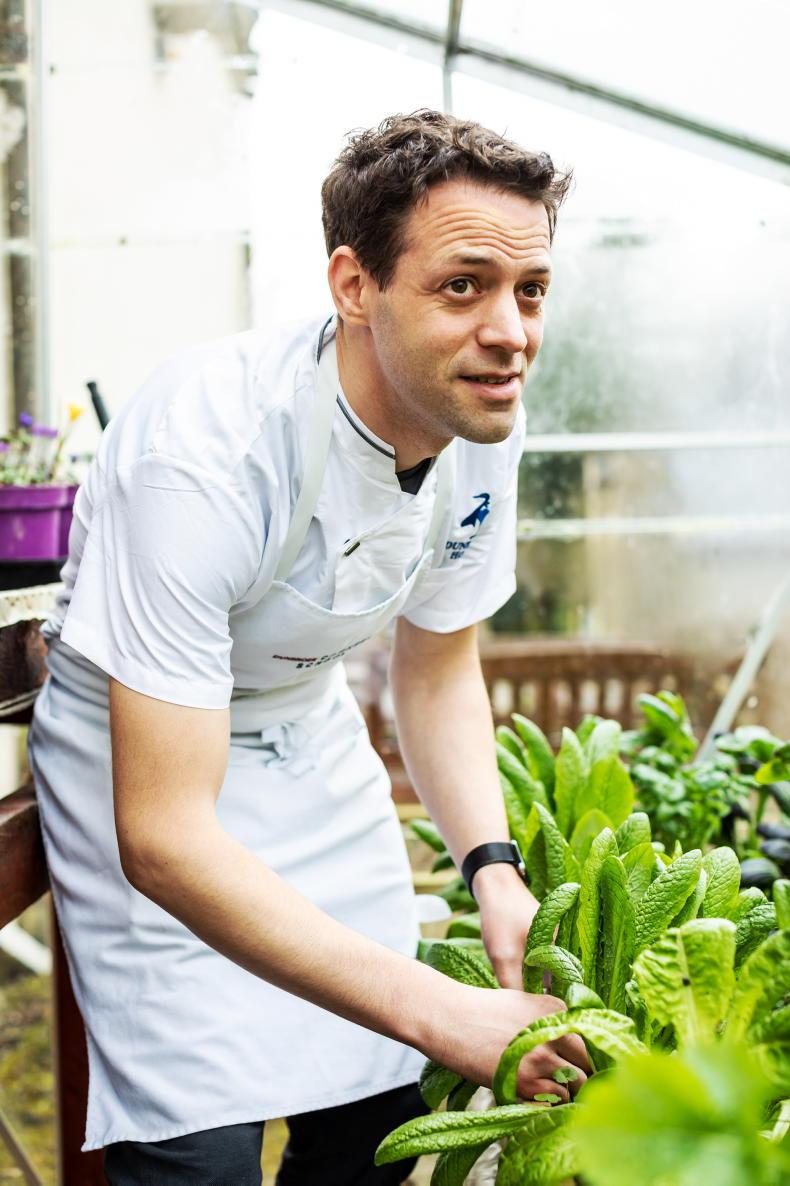
Julien Clémot manages the Dunbrody House Cookery School and can usually be found in Kevin's cookery studio or in the gardens at Dunbrody House \ Philip Doyle
“I’m a big fan of having family around the table anyways, but holidays like Easter give you an excuse to get even more of your family around the table,” he smiles. “Easter is probably my favourite time of year because it’s the time when everything is coming alive again. What better way to celebrate that than with a delicious meal?”
Roasted buttermilk leg of lamb
Serves six to eight
I just adore spring lamb, it has such a delicate flavour. It is a tradition for my wife, Catherine, to request of having a leg of lamb for our Easter dinner and we all adore it. We source our meat from a local lamb farm in Fethard-on-Sea and the flavour is just beautiful. The buttermilk tenderises the meat and adds an extra layer of flavour to the finished product.
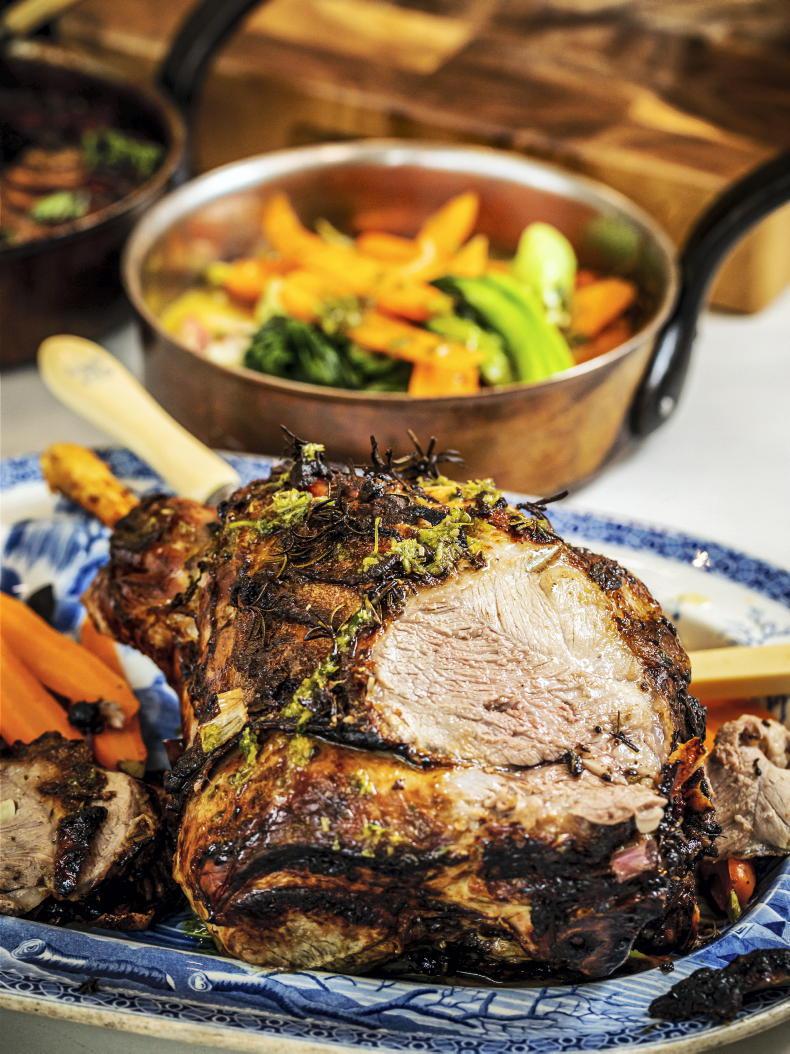
By brining the leg of lamb in buttermilk, the meat is tenderises and injected with an extra dose of flavour \ Philip Doyle
Ingredients
2l buttermilk
2 tbsp honey
2 tbsp Dijon mustard (we use local Filligans Dijon mustard), plus more for brushing onto the lamb
1 leg of lamb (approximately 2kg/4lb 8oz in size)
2-3 sprigs of rosemary, plus more for seasoning the lamb
1 bulb of garlic, halved horizontally
3 carrots, peeled and cut into large chunks
3 large onions, roughly chopped
6-8 cloves of garlic (for inserting into the lamb)
3 tbsp Irish rapeseed oil
Salt & pepper, for seasoning the lamb
Wild garlic and carrot fan pesto, to drizzle (see recipe page 29)
1 In a bowl or container, combine the buttermilk, honey, mustard, rosemary and half of the garlic. Add the leg and marinate for at least two to three hours, or overnight if possible.
2 Preheat the oven to 200°C.
3 On a large roasting tray, arrange the chunks of carrot, onions and the remaining half of the garlic to form a trivet. The leg of lamb will rest on this pile of vegetables.
4 Remove the leg of lamb from the buttermilk and lay it on top of the vegetables. Using a sharp knife, make a number of incisions into the fat of the lamb and insert the additional cloves of garlic along with some sprigs of the rosemary. Brush with extra mustard and season well with salt and pepper.
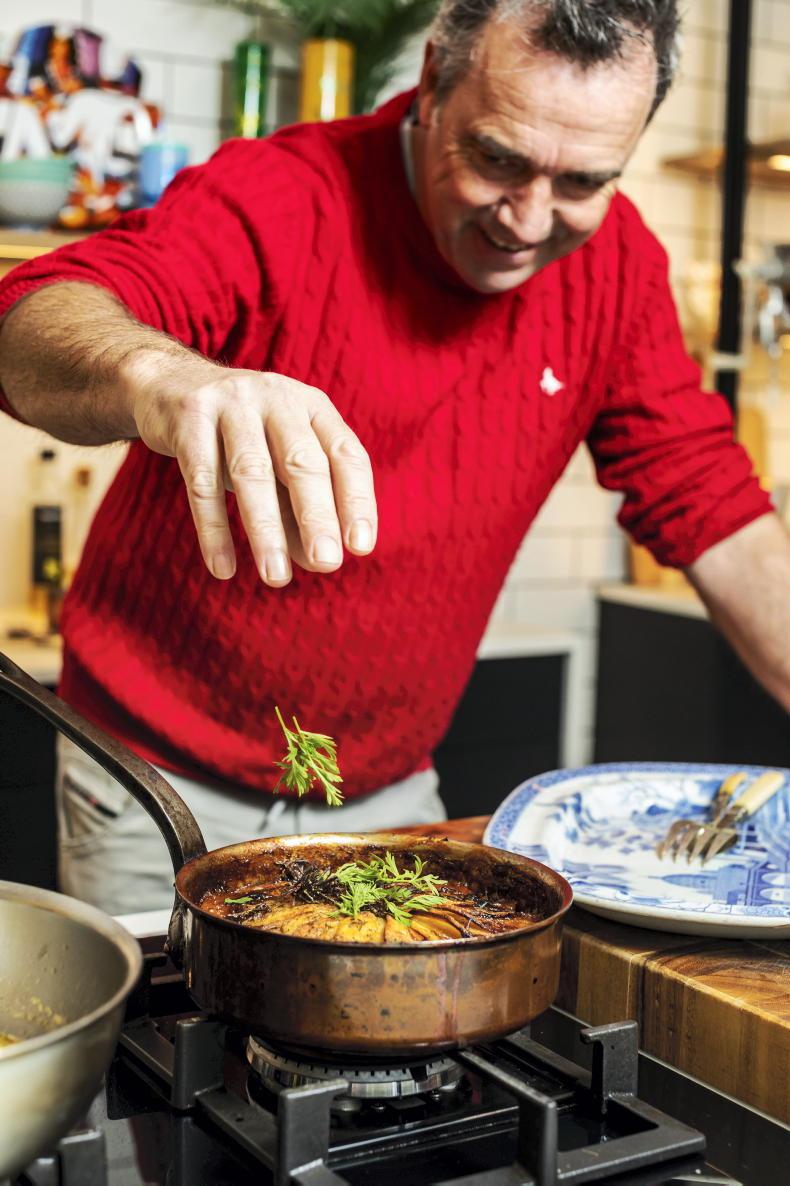
Kevin believes in using the best, freshest ingredients and preparing them simply to show off their best features \ Philip Doyle
5 Drizzle with the oil and give the leg of lamb a good rub. Roast in the oven for 60 to 90 minutes (15 minutes per 1lb/450g for rare, or 20 minutes for medium) adding an extra 15 minutes to the final cooking time.
6 Remove from the oven and allow the meat to rest for at least 15 minutes before carving. This allows the juices in the meat to redistribute throughout the leg; keeping the meat nice and flavourful.
7 Drizzle some wild garlic pesto to serve and carve as needed.
Serves four
We all love a good potato dauphinoise at Easter, but the rich, creamy dish can sometimes be a bit heavy. Instead of cream, these Boulangere potatoes are cooked in wine and chicken or vegetable stock, making them beautifully tender and flavourful – and light enough to come back for seconds.
Ingredients
70g butter, plus more for greasing the dish and dotting on top of the potatoes
4 medium onions, thinly sliced
3-4 cloves of garlic, finely chopped
100ml white wine
900g rooster Potatoes, uniformly sliced (use a mandolin here for best results)
800ml chicken stock or strong vegetable stock
4-5 sprigs of thyme
1 sprig rosemary
2 tsp salt
½ tsp pepper
1 Preheat the oven to 160°C.
2 In a saute pan over medium heat, melt the butter and add the onions, garlic, thyme and rosemary.
3 Cook without stirring for two minutes. Once the onions start to caramelise, stir once or twice and continue to cook for a further two minutes until nicely browned and the bottom of the pan starts to stick a little.
4 Next, add the white wine and gently stir to catch all that flavour on the bottom of the pan. Remove from the heat and set aside.
5 Grease an ovenproof dish with butter and add a layer of potatoes, followed by a layer of the caramelised onion mixture. Continue to layer potatoes and onions, finishing with a layer of potato.
6 Add the salt and pepper to the stock and pour it over the potatoes. Dot the top with some extra knobs of butter and add a few more sprigs of thyme and rosemary, if desired.
7 Cover loosely with foil and bake in the oven for 90 minutes to ?two hours or until the potatoes are soft, and the stock has mostly evaporated.
8 Keep warm or cool and store in the fridge for two to four days.
Wild garlic and honey glazed carrots
Serves six
here is my version of sweet and buttery Vichy-style carrots. When cooking, make sure you shake the pan occasionally to prevent the bottom catching and the glaze caramelizing. I find that these carrots reheat very well, so feel free to make them well in advance. When you’re ready to serve, just warm them through in a pan on the stove top.
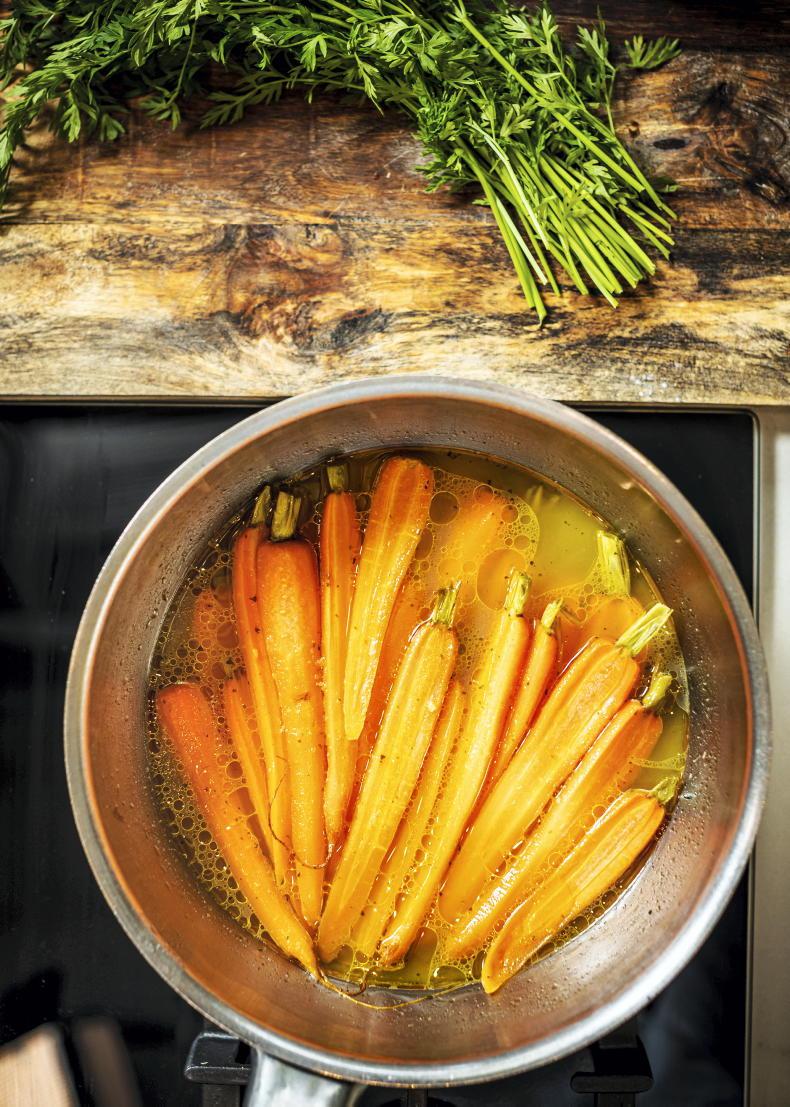
This is Kevin's take on sweet and savoury Vichy-style carrots \ Philip Doyle
Ingredients
450g baby carrots, halved straight down the middle
25g butter
2 tbsp honey
300ml vegetable stock
Salt and freshly ground black pepper
2 tbsp wild garlic and carrot fan pesto (see recipe below)
1 In a single layer, place the carrots in a wide saucepan with the butter, honey and enough vegetable stock to just cover the carrots. Sprinkle over a good pinch of salt and some freshly ground pepper.
2 Cover the saucepan with a lid and bring to a boil, then reduce the heat to medium-high and cook for about 12 minutes, shaking the pan occasionally to prevent sticking, until the carrots are tender and all of the liquid has evaporated.
3 Remove the pan from the heat and set aside to keep warm until needed.
4 Just before serving, add the pesto and toss to coat. Serve immediately.
Wild garlic and carrot fan pesto
Makes 200g pesto
This is an original way to create a delicious pesto using foraged leaves of wild garlic (which is in season at this time of year) and carrot fans. Pick only the young wild garlic leaves to achieve the best flavour. You can use the fans from the carrots in the previous recipe to avoid unnecessary food waste. If you don’t have any carrot fans though, you can replace them with the same amount of flatleaf parsley. Kylemore cheese is made in the west of Ireland and its delicious flavour is ideal paired with the wild garlic.
Ingredients
2 large handfuls of fresh wild garlic, roughly chopped
1 large handful of carrot fans (the green parts of the carrot) or flatleaf parsley, roughly chopped
2 tbsp Kylemore cheese, grated
Juice of ½ lemon
2 tbsp pine nuts
100-150ml sunflower oil
Salt and pepper, to taste
1 Place the wild garlic, carrot fans, cheese, lemon juice, pine nuts, salt and pepper in a food processor and pulse once or twice.
2 Turn the food processor on low and, while pulsing, add the oil in a slow drizzle to create a thick pesto. You may not use all 150ml of oil, so keep an eye on the texture as you drizzle. When the desired thickness is reached, turn off the food processor and have a small taste of the pesto. Adjust the seasoning; adding more salt and pepper, if needed.
3 Transfer the pesto into a clean jar with a tight-fitting lid. Before sealing, add an extra drop of oil over the top. This will keep the pesto from being exposed to air and oxidising; meaning it will last longer in the fridge.
4 Keep in the fridge for up to four months.
Sauteed spring vegetables
Serves four
At Easter time, the gardens at Dunbrody House are just beginning to provide, with the promise of a long season ahead. At the time of writing, we were able to harvest baby radishes and pak choi, so these are the vegetables we used for this recipe. You could use almost anything here: green beans, peas, spinach, leeks. This method will work with almost any tender green vegetable.

Kevin used pak choi in this sauteed greens dish, but you can use whichever tender green vegetables you like \ Philip Doyle
Ingredients
40g butter
1 onion, thinly sliced
2 pak choi, quartered
200g young radishes, halved
100ml vegetable stock
100ml white wine
4-6 spring onions, thinly sliced
2 tbsp fresh parsley, finely chopped
Salt and pepper, to taste
1 In a large saute pan, melt the butter. Add the onion and saute until softened, but not browned. Add the pak choi and radishes and toss to coat in the butter.
2 Pour in the vegetable stock and white wine. Season with salt and pepper. Simmer for two minutes and then add the spring onion.
3 Continue to simmer for another minute.
4 Remove from the heat. Have a taste of the wine/butter/stock sauce to check for seasoning and adjust, if needed. Sprinkle the chopped parsley over the top and serve immediately.
Read more
The Producer’s Plate: upping your holiday brunch game with Killarney Urban Farm
Standout restaurant meals of 2022
Growing up, Easter was always a special time for me and my family,” chef Kevin Dundon tells Irish Country Living. “My mom was an amazing cook and we always had roast spring lamb for our Easter dinner. It was a kind of the mark in the year as the first of the spring lamb. We looked forward to that every year.”
We are in Kevin’s cooking studio at his Ireland’s Blue Book-listed hotel, Dunbrody Country House, which is located in Arthurstown in costal Co Wexford. The sun is shining, the gardens are starting to come to life and we are sampling the beautiful recipes, which are now being shared in this spread. Kevin and Julien Clémot, who manages the Dunbrody House Cookery School, work together to develop new courses (which can be booked online and do not require a hotel stay) and produce content for Kevin’s social media streams, which currently include daily live cooking sessions on Instagram and Facebook at 2pm. I ask Kevin if Easter is a big thing in the Dundon household and how he likes to celebrate. He says it’s all about family and good food.

Julien Clémot manages the Dunbrody House Cookery School and can usually be found in Kevin's cookery studio or in the gardens at Dunbrody House \ Philip Doyle
“I’m a big fan of having family around the table anyways, but holidays like Easter give you an excuse to get even more of your family around the table,” he smiles. “Easter is probably my favourite time of year because it’s the time when everything is coming alive again. What better way to celebrate that than with a delicious meal?”
Roasted buttermilk leg of lamb
Serves six to eight
I just adore spring lamb, it has such a delicate flavour. It is a tradition for my wife, Catherine, to request of having a leg of lamb for our Easter dinner and we all adore it. We source our meat from a local lamb farm in Fethard-on-Sea and the flavour is just beautiful. The buttermilk tenderises the meat and adds an extra layer of flavour to the finished product.

By brining the leg of lamb in buttermilk, the meat is tenderises and injected with an extra dose of flavour \ Philip Doyle
Ingredients
2l buttermilk
2 tbsp honey
2 tbsp Dijon mustard (we use local Filligans Dijon mustard), plus more for brushing onto the lamb
1 leg of lamb (approximately 2kg/4lb 8oz in size)
2-3 sprigs of rosemary, plus more for seasoning the lamb
1 bulb of garlic, halved horizontally
3 carrots, peeled and cut into large chunks
3 large onions, roughly chopped
6-8 cloves of garlic (for inserting into the lamb)
3 tbsp Irish rapeseed oil
Salt & pepper, for seasoning the lamb
Wild garlic and carrot fan pesto, to drizzle (see recipe page 29)
1 In a bowl or container, combine the buttermilk, honey, mustard, rosemary and half of the garlic. Add the leg and marinate for at least two to three hours, or overnight if possible.
2 Preheat the oven to 200°C.
3 On a large roasting tray, arrange the chunks of carrot, onions and the remaining half of the garlic to form a trivet. The leg of lamb will rest on this pile of vegetables.
4 Remove the leg of lamb from the buttermilk and lay it on top of the vegetables. Using a sharp knife, make a number of incisions into the fat of the lamb and insert the additional cloves of garlic along with some sprigs of the rosemary. Brush with extra mustard and season well with salt and pepper.

Kevin believes in using the best, freshest ingredients and preparing them simply to show off their best features \ Philip Doyle
5 Drizzle with the oil and give the leg of lamb a good rub. Roast in the oven for 60 to 90 minutes (15 minutes per 1lb/450g for rare, or 20 minutes for medium) adding an extra 15 minutes to the final cooking time.
6 Remove from the oven and allow the meat to rest for at least 15 minutes before carving. This allows the juices in the meat to redistribute throughout the leg; keeping the meat nice and flavourful.
7 Drizzle some wild garlic pesto to serve and carve as needed.
Serves four
We all love a good potato dauphinoise at Easter, but the rich, creamy dish can sometimes be a bit heavy. Instead of cream, these Boulangere potatoes are cooked in wine and chicken or vegetable stock, making them beautifully tender and flavourful – and light enough to come back for seconds.
Ingredients
70g butter, plus more for greasing the dish and dotting on top of the potatoes
4 medium onions, thinly sliced
3-4 cloves of garlic, finely chopped
100ml white wine
900g rooster Potatoes, uniformly sliced (use a mandolin here for best results)
800ml chicken stock or strong vegetable stock
4-5 sprigs of thyme
1 sprig rosemary
2 tsp salt
½ tsp pepper
1 Preheat the oven to 160°C.
2 In a saute pan over medium heat, melt the butter and add the onions, garlic, thyme and rosemary.
3 Cook without stirring for two minutes. Once the onions start to caramelise, stir once or twice and continue to cook for a further two minutes until nicely browned and the bottom of the pan starts to stick a little.
4 Next, add the white wine and gently stir to catch all that flavour on the bottom of the pan. Remove from the heat and set aside.
5 Grease an ovenproof dish with butter and add a layer of potatoes, followed by a layer of the caramelised onion mixture. Continue to layer potatoes and onions, finishing with a layer of potato.
6 Add the salt and pepper to the stock and pour it over the potatoes. Dot the top with some extra knobs of butter and add a few more sprigs of thyme and rosemary, if desired.
7 Cover loosely with foil and bake in the oven for 90 minutes to ?two hours or until the potatoes are soft, and the stock has mostly evaporated.
8 Keep warm or cool and store in the fridge for two to four days.
Wild garlic and honey glazed carrots
Serves six
here is my version of sweet and buttery Vichy-style carrots. When cooking, make sure you shake the pan occasionally to prevent the bottom catching and the glaze caramelizing. I find that these carrots reheat very well, so feel free to make them well in advance. When you’re ready to serve, just warm them through in a pan on the stove top.

This is Kevin's take on sweet and savoury Vichy-style carrots \ Philip Doyle
Ingredients
450g baby carrots, halved straight down the middle
25g butter
2 tbsp honey
300ml vegetable stock
Salt and freshly ground black pepper
2 tbsp wild garlic and carrot fan pesto (see recipe below)
1 In a single layer, place the carrots in a wide saucepan with the butter, honey and enough vegetable stock to just cover the carrots. Sprinkle over a good pinch of salt and some freshly ground pepper.
2 Cover the saucepan with a lid and bring to a boil, then reduce the heat to medium-high and cook for about 12 minutes, shaking the pan occasionally to prevent sticking, until the carrots are tender and all of the liquid has evaporated.
3 Remove the pan from the heat and set aside to keep warm until needed.
4 Just before serving, add the pesto and toss to coat. Serve immediately.
Wild garlic and carrot fan pesto
Makes 200g pesto
This is an original way to create a delicious pesto using foraged leaves of wild garlic (which is in season at this time of year) and carrot fans. Pick only the young wild garlic leaves to achieve the best flavour. You can use the fans from the carrots in the previous recipe to avoid unnecessary food waste. If you don’t have any carrot fans though, you can replace them with the same amount of flatleaf parsley. Kylemore cheese is made in the west of Ireland and its delicious flavour is ideal paired with the wild garlic.
Ingredients
2 large handfuls of fresh wild garlic, roughly chopped
1 large handful of carrot fans (the green parts of the carrot) or flatleaf parsley, roughly chopped
2 tbsp Kylemore cheese, grated
Juice of ½ lemon
2 tbsp pine nuts
100-150ml sunflower oil
Salt and pepper, to taste
1 Place the wild garlic, carrot fans, cheese, lemon juice, pine nuts, salt and pepper in a food processor and pulse once or twice.
2 Turn the food processor on low and, while pulsing, add the oil in a slow drizzle to create a thick pesto. You may not use all 150ml of oil, so keep an eye on the texture as you drizzle. When the desired thickness is reached, turn off the food processor and have a small taste of the pesto. Adjust the seasoning; adding more salt and pepper, if needed.
3 Transfer the pesto into a clean jar with a tight-fitting lid. Before sealing, add an extra drop of oil over the top. This will keep the pesto from being exposed to air and oxidising; meaning it will last longer in the fridge.
4 Keep in the fridge for up to four months.
Sauteed spring vegetables
Serves four
At Easter time, the gardens at Dunbrody House are just beginning to provide, with the promise of a long season ahead. At the time of writing, we were able to harvest baby radishes and pak choi, so these are the vegetables we used for this recipe. You could use almost anything here: green beans, peas, spinach, leeks. This method will work with almost any tender green vegetable.

Kevin used pak choi in this sauteed greens dish, but you can use whichever tender green vegetables you like \ Philip Doyle
Ingredients
40g butter
1 onion, thinly sliced
2 pak choi, quartered
200g young radishes, halved
100ml vegetable stock
100ml white wine
4-6 spring onions, thinly sliced
2 tbsp fresh parsley, finely chopped
Salt and pepper, to taste
1 In a large saute pan, melt the butter. Add the onion and saute until softened, but not browned. Add the pak choi and radishes and toss to coat in the butter.
2 Pour in the vegetable stock and white wine. Season with salt and pepper. Simmer for two minutes and then add the spring onion.
3 Continue to simmer for another minute.
4 Remove from the heat. Have a taste of the wine/butter/stock sauce to check for seasoning and adjust, if needed. Sprinkle the chopped parsley over the top and serve immediately.
Read more
The Producer’s Plate: upping your holiday brunch game with Killarney Urban Farm
Standout restaurant meals of 2022













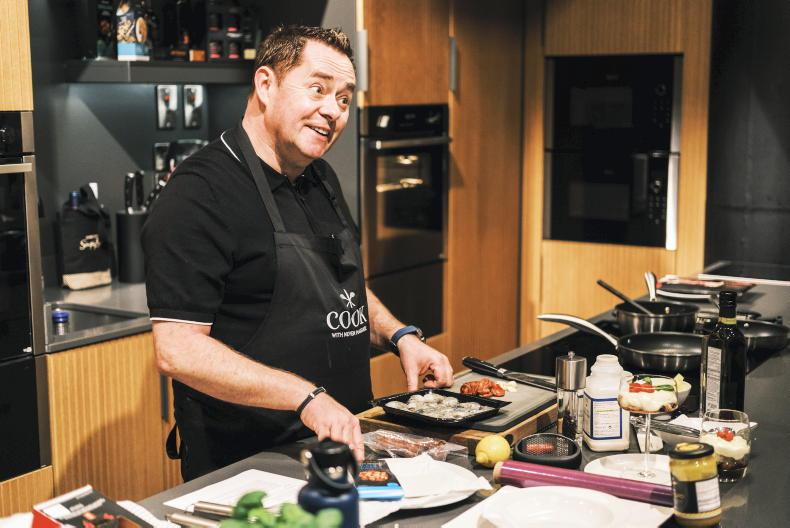
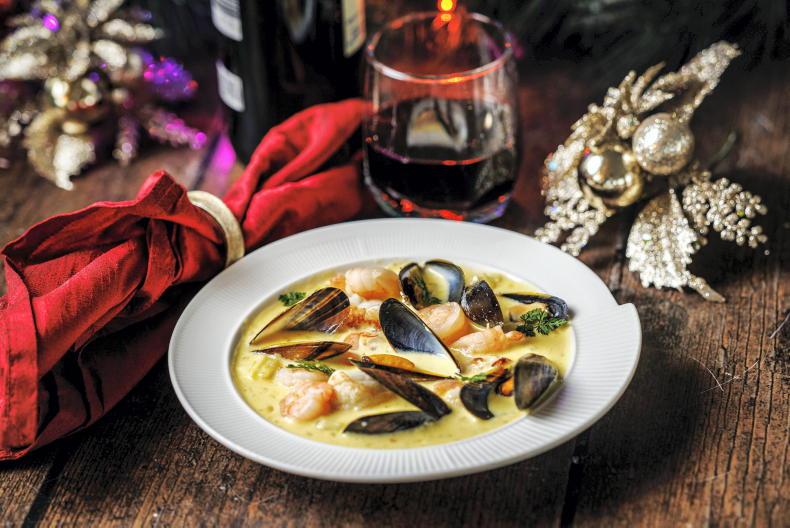
SHARING OPTIONS